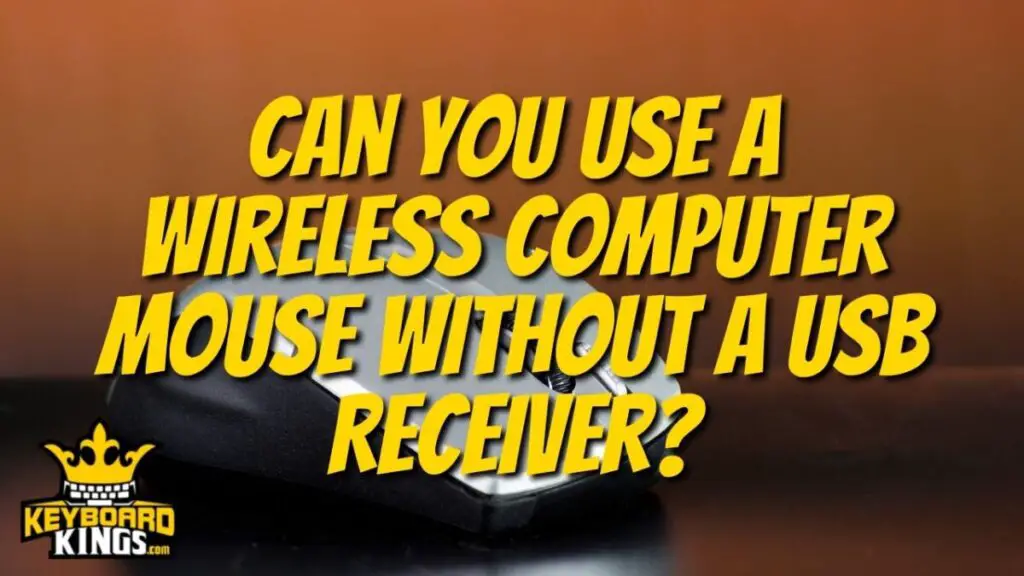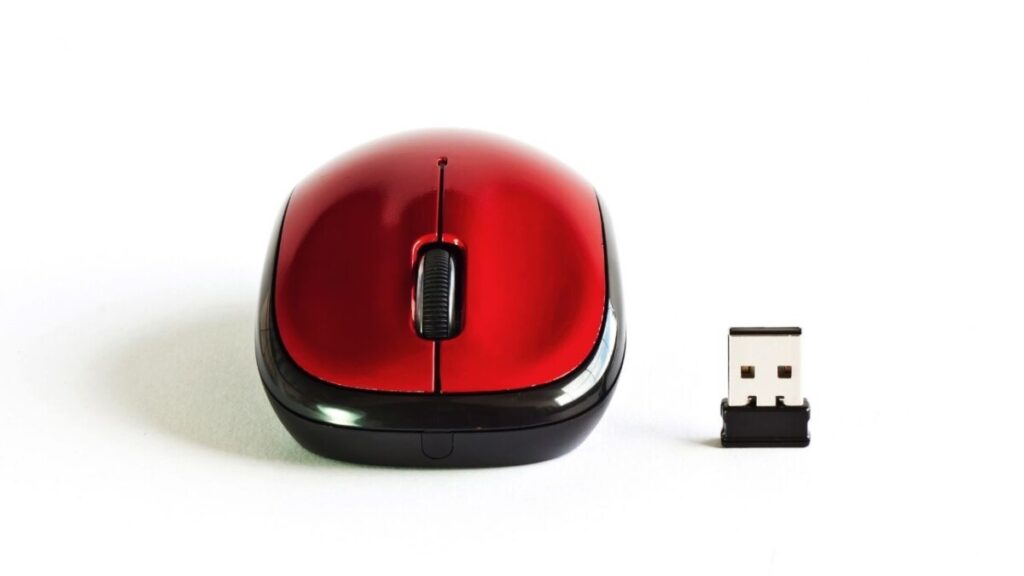Computer mice are absolutely essential to the operations of a computer system. Whenever there’s an issue with the computer mouse, your entire computer usage can come to a halt. Especially in the case of a wireless mouse, you may experience lots of glitches when its USB receiver is lost.
A lot of people wonder if it’s possible to use a wireless computer mouse without a USB receiver. Well, it depends on the operating system you’re using and how the mouse works. If it’s Bluetooth or Wi-Fi enabled, there shouldn’t be any problem.
Nevertheless, a series of steps need to be taken in order to make it happen if you have lost your USB receiver. So, in this article, I’m going to talk about how wireless mice work and whether there’s any way to make them work without a USB receiver.
We will also look at the step-by-step guide and talk about whether wireless mice are worth all the hype.
Let’s get started!

Table of Contents
How do Wireless Computer Mice work?
Wireless Computer mice tend to work similarly to wired computer mice. When it comes to the whole process of how the mouse and computer communicate, the computer system processes the received input signals, usually done by clicking buttons on the mouse, to perform actions. But, the difference between wireless and wired computer mice exists in the style of transmission of the signals.
These mice tend to use one of three available kinds of connection types. One of these types is through a USB receiver dongle which needs to be connected to the computer system and receives the signals from the mouse when a button is pressed.
The second way is through a Wi-Fi connection. This also requires a Wi-Fi USB to be connected to the computer or a built-in Wi-Fi receiver in the system so that the transferred Wi-Fi signal can be caught and then processed by the CPU of the computer effectively.
The final and ideally the best connection type for a wireless mouse to work properly on a computer system is through Bluetooth.
If your computer offers built-in Bluetooth functionality, all you really need is Bluetooth connectivity enabled in the mouse, and you’ll be able to connect it and send all the signals through it. It is also one of the faster transmission types for wireless mice which is why computer users prefer Bluetooth mice.
Do Wireless Mice Work Without a USB Receiver?
Wireless computer mice work on one of a few wireless connection technologies available in the industry right now. One of those technologies is through a USB receiver dongle that needs to be connected to the computer system.
But, since the USB receiver is a very small component and is difficult to manage, at times, it can get lost or stop working, which can put a stop to the functioning of your wireless mouse.
In such a case, you’re going to want to know if there’s any other way you can use a wireless mouse with your computer system. Well, luckily, wireless mice can work without a USB receiver.
But, there’s one condition associated with that. The condition is that the wireless mouse you’re using needs to have some backup connectivity in it so that it can still keep working with your computer.
There are basically two other technologies that can make your wireless mouse work without a USB receiver: Bluetooth technology and Wi-Fi technology. Let’s talk about both of them to understand how you can use your computer mouse without a USB receiver.
Wireless Mouse with Bluetooth
The first way of using your wireless mouse without a USB receiver is through Bluetooth technology. Typically, wireless mice that offer Bluetooth connectivity don’t have USB dongle technology in them, but in some special cases, this could be possible.
If the mouse you’re using comes with this technology in it, then you’re definitely going to be able to use the wireless mouse without requiring any kind of USB receiver.
Well, you might be thinking, how does a Wireless mouse with Bluetooth tend to work? Let’s take a look at the step-by-step process of the function of a Bluetooth wireless mouse.
- First of all, you’re going to turn on the Bluetooth technology used in your wireless mouse so that it can become pairable with the computer system you want to use the mouse on.
- The next thing you’re going to do is turn on Bluetooth on the computer so that it can detect the wireless mouse whose USB receiver you don’t have right now.
- It is now time to pair and connect both these devices with each other. These devices will connect as long as they’re working well and then you’ll be able to use the mouse.
- Each of the button presses, movements, and functions of the mouse will be tracked onto the cursor pointer on the monitor screen of the computer system.
- The signals will be sent through Bluetooth technology and be caught and then processed by the CPU of the computer which will turn them into performable actions.
The range of Bluetooth wireless mice is right around 33 feet usually, which is significant enough for any wireless mouse user experience. That’s why Bluetooth wireless mice are preferred over older mouse technologies nowadays.
Many of the professional gamers, streamers, and even office workers that you might see using wireless mice will mostly be using Bluetooth mice because they’re easier to operate, maintain, and function. Plus, the inclusion of new technologies and features in modern Bluetooth mice truly make them a spectacle to have in your computer setup.
Wireless Mouse With Wi-Fi Connectivity
Another way of using your wireless mouse without its USB receiver is through Wi-Fi connectivity. Some computer mice come with both the capabilities of USB dongle connectivity and Wi-Fi connectivity.
So, if you end up somehow misplacing or losing your USB dongle, you can still use the wireless mouse if your current mouse has a Wi-Fi connectivity option available in it. It is that simple.
Now, there are a couple of different ways the Wi-Fi connectivity of a wireless mouse works. You can use this technology to make your mouse work in case you don’t have the USB receiver for it. Let’s take a look at how a wireless mouse works with Wi-Fi connectivity.
- Your computer system is going to need one of two inclusions to be able to connect a Wi-Fi wireless mouse to it. One of these inclusions is a Wi-Fi receiver built into the motherboard of the computer.
- If that’s not the case, then, you’re going to have to use a Wi-Fi USB receiver so that it can catch the signals of the wireless mouse and then perform its actions respectively.
- After that, the process is quite simple. If the mouse comes with Wi-Fi support, you’re going to be able to press the buttons and all the movements and presses will be tracked.
- These movements will end up getting processed by the CPU and then perform output actions. These actions are going to be seen happening on the monitor in real-time.
The range of a Wi-Fi connection is around 46 meters, which is more than Bluetooth. However, when it comes to responsiveness between the mouse and the computer, the Bluetooth mice definitely take the win without a doubt.
But still, if you don’t have a USB receiver with your mouse and it supports Wi-Fi connectivity, then you should definitely think about using this other connectivity type. You’ll be able to use your mouse on your computer system without facing any kind of problem at all.
Wireless Mouse USB Receiver Issues
Getting a wireless mouse comes with a lot of benefits and ease, but at the same time, there are a few issues you can encounter as well. To know what kind of problem you’ve faced with your wireless mouse’s USB receiver, let’s take a look at some of the common problems that these little dongles get into.
USB Receiver is Lost
The first and most common problem that people using wireless mice face is losing the USB receiver. Since the size of the USB dongle is so small, it can easily get misplaced. In fact, sometimes the USB receiver can’t be stored anywhere since there isn’t any compartment available on the mouse for it, which also ends up being the reason for its untimely loss.
USB Receiver is Broken
Another very common issue for a wireless mouse is the USB receiver somehow breaking. USB receiver dongles aren’t the most durable devices in the world, which is why they’re likely to break due to too much pressure. If you don’t keep the USB receiver in a safe place, it will most likely break or the internal circuitry might get damaged. This can ultimately lead to the receiver not working as intended.
USB Port Issues
Sometimes you might think that the USB receiver you’re using with your wireless mouse is causing the issue, but in fact, it isn’t the culprit. The real problem exists within the USB port of the computer.
In such cases, the ideal solution to your problem is just taking the USB receiver out and trying to plug it in a different socket. If it starts working, you’re going to have to get the USB port you’re using fixed if you want to make sure that no such problem repeats again.
Mouse Driver Problems
Another problem that you might be associating with your USB receiver is the issue with your mouse drivers. Sometimes your wireless mouse may not be working due to a problem that exists within your mouse drivers. They could be corrupted, broken, or simply deleted.
If that’s what’s wrong with your computer, what you’re going to need to do is simply delete, rollback, or update your mouse driver from the Device Manager menu. Then, reboot your computer. Once the reboot is successful, your wireless mouse will start working great again.
What to Do if Wireless Mouse USB Receiver is Lost?

Wireless Mouse USB receivers are quite small and fragile. Once you plug them into the port on your laptop or computer system, you’re likely going to forget that they exist. But, even in such cases, sometimes they can get misplaced.
If you somehow end up misplacing and losing your USB receiver dongle, your wireless mouse has a lot of chances of becoming useless. In that case, the only thing you can really do is get a new wireless mouse.
Your new mouse should preferably have a USB receiver hidden compartment so that you can stash the dongle into that compartment once you’re done using the mouse.
It would also be good to get a wireless mouse that comes with more than a single USB receiver so that any kind of misplacement of the first one doesn’t stop you from using your wireless mouse.
At other times, it is possible that you may lose your USB receiver, but there’s still hope for your mouse to work without having to be replaced with a completely new one. As I said before, with the help of other connection types like Bluetooth and Wi-Fi, you can still keep your mouse in use and not throw it away so easily.
Wireless Mouse Buying Guide
If you’re thinking of buying a wireless mouse for your computer system, you’re going to want to make sure you’re getting the right deal. Well, to make this choice easier for you, here’s a quick guide on which things to consider important and which factors to think about before you buy your own wireless mouse:
- Connection Type – Wireless mice are available in a few different connection types nowadays. You can get a Bluetooth wireless mouse, and is going to allow you to connect your mouse to the computer without any external USB receiver. Or, you can get a USB receiver or Wi-Fi mouse which is wireless but still requires external receiver devices to be plugged into the computer systems.
- DPI – Another very important factor to consider is the DPI range of the mouse. You need to make sure that the wireless mouse you’re getting comes with a decent DPI range so that it can be used for a variety of computer-related tasks and purposes including working and gaming as well.
- Functionalities – You also need to carefully check out the functionalities and the capabilities that the wireless mouse you’re getting has in it. These functionalities can range from being able to switch devices, offer macro support, have onboard profiles, and much more as well. So, keep a look out for these add-ons.
- RGB – RGB lighting on the wireless mouse you buy isn’t necessary, but it can definitely add a lot of pizazz to your computer setup. Plus, having benefits like customizable lighting and other stuff can also make your overall wireless mouse usage experience loads of times better. That’s why RGB is something you should consider important if you like it.
- Ergonomics – One of the most important aspects to look out for when buying a mouse is the ergonomic structure of the wireless mouse. You need to make sure the body of the mouse is contoured enough with a number of rests for all of your fingers so that you don’t feel any kind of strain when you’re using the mouse for any amount of time.
- Response Time – Wireless mice are often considered to be slower than wired ones. So, you need to make sure the wireless mouse you’re getting comes with a quick response time that is capable of delivering maximum performance and, at the same time, works effortlessly.
Are Wireless Mice Worth It?
Other than the fact that sometimes wireless mice tend to be on the slower end when it comes to responsiveness, they are definitely worth it. These devices are compact, easy to use, portable, and can be used for both gaming and working as well.
So, you should definitely think about getting one for your computer system. Just make sure if you’re getting a USB receiver wireless mouse, you keep it safe or if you can afford it, get a Bluetooth wireless mouse or a Wi-Fi one. If you do, you won’t even have to think too much about the USB receiver and where to keep it.
Conclusion
Wireless mice are great when it comes to portability and compactness, but make sure you get a wireless mouse that comes with a compartment for the USB receiver or a connection technology that doesn’t require the constant caretaking of a USB dongle, like Bluetooth.
This way, you’ll be able to benefit from all the good things in a Wireless mouse without encountering any of the problems. I hope you learned a lot from this article and that you’re going to have a great time using your wireless mouse. May you have a great day and life ahead of you!
